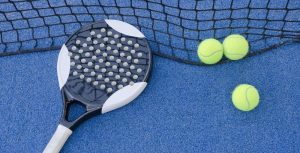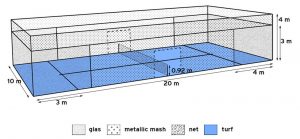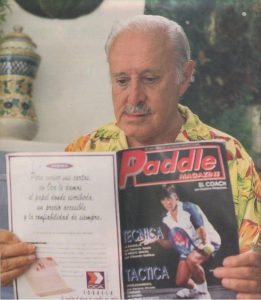Know them padel rules? Have you ever played it?
In this article we will talk about the rules of padel, a sport born in Mexico in the 70s due to an error of judgment, currently very popular, cheap and which entertains 6.5 million players worldwide.
What is Padel
The padel is one sport similar to tennis, in Anglo-Saxon countries it is commonly called "paddles”, which is played with one racket per player and a tennis-like ball.
The name "Paddle" literally means "paddle", which is a type of oar. The Italianized version of "Paddle" is, in fact, "Padel", which recalls the word "padella", a tool very similar to the racket used to play this sport.
The padel differs from tennis because of the rackets; since in padel the rackets are more "stocky" and are without strings on the two sides where the ball falls, but have a surface with holes that can be smooth or rough.
Furthermore, there ball in the game of padel it is smaller and softer compared to that of tennis, as its internal pressure is lower than the tennis ball.
In the end, the field from padel it has a size of about 1/3 compared to a tennis court and can be made with different materials, such as: concrete, concrete, synthetic grass or, in any case, a surface that allows a regular bounce of the ball, unlike tennis which must have a clay court, grass or hard earth (such as asphalt, concrete or 'acrylic).

The Rules of Padel
In addition to the shape and size of the racket and ball, padel differs from tennis in size, court structure and game rules.
How to Play Padel
We can define the rules of padel as follows:
- Training: padel is played exclusively in teams (which can also be mixed), made up of two elements each – one pair serves and the other receives, it is the draw that decides which of the two teams starts with the service -. In total, there must be four players per game.
- Team play: the ball cannot be hit simultaneously by both team members and cannot be touched more than once during the return.
- Joke: to serve, the ball first has to bounce on the ground and then you can hit it towards the opponent's court. The ball must either bounce in the opposite court, or it may touch one of the walls of the opponent's court and rebound on that court at most once before being sent back to the original court. When batting, the player who serves must stand diagonally opposite the opponent's batting area. The joke must be made on the "service line".
- Moving ball: in padel it is basic always keep the ball in motion and this is also favored by the composition of the playing field. In fact, if the ball hits a wall, it will then rebound to the ground and you can hit it towards the opponent's court. On the other hand, the ball cannot touch the walls located in the opponent's field on the fly, nor the metal mesh, nor can it bounce twice on the floor.
- Just do it: the ball can only hit the racket, the court and the walls, if it hits the opponent's body it is a foul.
Furthermore, a player can hit the ball and make it bounce on the opponent's half of the field causing, after the rebound, the ball to leave the field fence. Players can also leave the field, through the appropriate lateral exits, to hit the ball, provided that the ball has not bounced more than once on the floor.
Finally, a player can hit the ball on any wall of his court (both back and sides) and cause it to pass over the net towards the opponent's court. Even the rebound from the corner of the field, between the walls and the floor, is considered a fair ball.
The Score In Padel
Scoring in the game of padel is identical to that in tennis.
Each point is scored when: the ball touches the walls of the opponent's field on the fly, the metal mesh and when it bounces twice on the opposite floor. Or, when, pushed by a player, it rebounds correctly on the opponent's field and then, having gone beyond the limits of the field, it hits some element or object foreign to the field, or when it bounces twice in a row on the opponent's field.
A team loses points if:
- the ball bounces twice on the court before being hit in the opposite court;
- a player hits the ball on the fly before it has crossed the net and reached it and is therefore still in the opponent's court;
- a player hits the ball and it touches the jersey or the floor of his court;
- the ball in play touches the player or anything he carries except the racket;
- a player returns the ball in such a way as to hit any wall of the opposite field on the fly, or the metal mesh or other elements that make up the field, such as: net, support posts, central belt or band;
- a player hits or touches the ball more than once in a return;
- both players hit the ball simultaneously or consecutively.
The Playing Field
 First, the playing field must have the following dimensions:
First, the playing field must have the following dimensions:
- 20 meters in length (+/- 0.10),
- 10 meters in width (+/- 0.05),
- overall, at least 6 meters coverage.
The net must be positioned in the middle of the court (about 6.95m from the "service line") and must be at least: high:
- 92cm at the ends of the field (+/- 0.5cm),
- 88cm in the center of the field (+/- 0,5cm),
with a white upper border band between 5 and 6.3cm, the two side posts of the net must be inside the playing field and their edge coincides with the edge of the field. If the posts are not positioned correctly on the sidelines, there will be an irregularity.
In addition to this, to allow the ball to bounce wherever it falls and always be in motion, the sides of the field must also be closed off by solid walls, walls or nets.
Padel Rules Vs. Tennis Rules
Basic, in padel the ball is always in motion, whereas in tennis it can come out from anywhere, it also changes the way you hit.
To serve in padel, you need to bounce the ball on the ground and hit it as soon as it reaches the height of the player's hip. In tennis, on the other hand, a serve is made by throwing the ball in the air and hitting it on the fly.
In both tennis and padel, the serve must be made diagonally.
If you are looking for your new clothing from padel, in this article you will find what you are looking for!
Brief History On The Birth Of Padel
The padel game was born in the 70s in Mexico from the idea of Enrique Corcuera, a noble citizen who wanted to create an area of his residence to be used for playing tennis.

Enrique Corcuera, the father of Padel.
Corcuera didn't have the space necessary to create a tennis court, but he still decided to exploit the area he had available to build a playing field, delimiting it with wire mesh to prevent the ball from leaving the field. Having a smaller area than a tennis court, he decided to change the rules of the game, making sure that the ball always remained in motion within the court. Thus was born, by pure chance, the padel.
Within a short time, the game spread, soon expanding beyond the Mexican borders, thus arriving also in Europe and, in particular, in Spain. And it is precisely in Spain that a prince had a field built in his hotel with the same characteristics as the one built by Corcuera, giving his customers the opportunity to play this new and different sport.
Sport soon arrived also in the beautiful country and so it was that in February 1991 the Italian Paddle Game Federation (FIGP), which was immediately successful, which was joined by various sports clubs including CONI
They are currently being played world Championships of this sport, with a large number of world titles won mainly by the countries of Argentina and Spain.